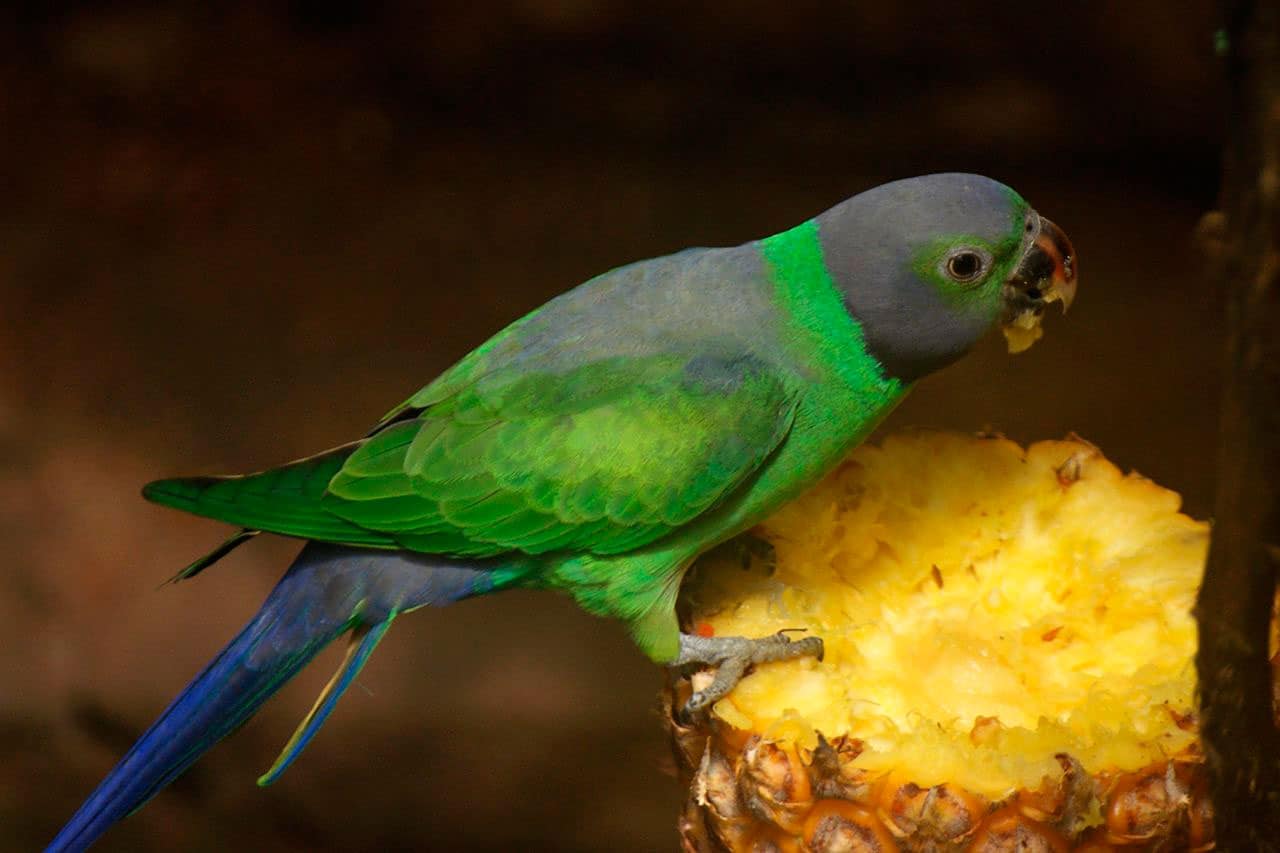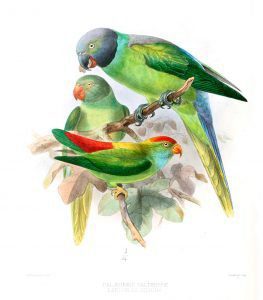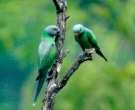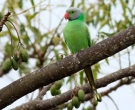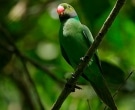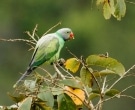Content |
|---|
Description:
29 cm., including its tail up 13 cm.. and 100 g. of weight.
The adult male of the (Psittacula calthrapae) Layard's Parakeet has the head and back bluish grey, separated by a neck green. There is a wide swath in the chin of black color and tail It is blue with a yellow tip. Upper bill the male is red, and the bill bottom is brown.
The female es similar, but has the bill top in black, and dark green stripe on the cheek. Lack the band pink in nape and the neck is greenish yellow. They have the blue tint in the rear of the head if you can see in males. Feathers middle of the tail You are washed with blue.
The immature they are like the females, but with feathers tail shorter, with a plumage mainly green and bill dark red.
Habitat:
Their preferred habitats are forested areas 1.600 meters above sea level, although registered at altitudes 2.000 m, taking advantage of a wide variety of vegetation types including natural and semi-natural moist forests, tea plantation and botanical gardens; often at the edge of the woods, generally in small groups or couples.
Sedentary, especially in mountain areas, but extending over the lowlands, especially in humid forests near sea level.
after feeding, the Layard's Parakeet congregate in trees chattering loud and persistent. Before break, roam issuing strong calls.
Reproduction:
The time of reproduction It is around January to May, with a high season from July to September.
The eggs They are deposited in a natural cavity or disused nest Woody Woodpecker or a bearded, usually at the top of a tree. Competition for nest sites is often intense, especially with Plum-headed Parakeet. The cavity is lined with rotting wood and dust. Two to four white eggs make commissioning. Both sexes share duties incubation and feed on young.
Food:
Diet Layard's Parakeet It is believed to be similar to the Rose-ringed Parakeet and Plum-headed Parakeet, although their arboreal habits make them more frugivores and less destructive to crops.
Registered with the company Brahminy Starling (Sturnia pagodarum) feeding fruit Map peltata (Macaranga tomentosa). Favorite foods include figs and fruit of wild cinnamon (Cinnamomum).
Distribution:
Size of the area of distribution (reproduction / resident): 18.900 km2
The Layard's Parakeet It is endemic in south-central and south-west Sri Lanka. In Provincia Central, North of Matale through highlands around south and west Kandy in Western Province and Sabaragamuwa to the North of On Provincia.
They are distributed also in the east, around the Gal Oya National Park and to the South, in Uva Province, until Haputale. A record of 1880 a bird against Eastern Province. Registration, unconfirmed, in the Maldives It is believed to come from leaks.
According to sources, abundant in the 19th century and apparently still numerous in some areas, but declining due to habitat loss arising, for example, conversion of natural and semi-natural forests and plantations capture for trade.
Conservation:
State of conservation ⓘ |
||
|---|---|---|
 Minor Concern ⓘ
(UICN)ⓘ
Minor Concern ⓘ
(UICN)ⓘ
| ||
• Current Red List of UICN: Least concern
• Population trend: Decreasing
The Psittacula calthrapae (del Hoyo and necklace 2014) It was previously listed as Psittacula calthropae.
The size of the world's population has not been quantified, but the species is reported as locally common (pit et to the. 1997).
The population is suspected of being in decline due to ongoing habitat destruction.
"Layard's Parakeet" in captivity:
Rare captive out of their range.
Alternative names:
– Layard’s Parakeet, Emerald-collared Parakeet (English).
– Perruche de Layard (French).
– Blauschwanzsittich (German).
– Periquito-de-colarinho-verde (Portuguese).
– Cotorra de Ceilán (español).
scientific classification:
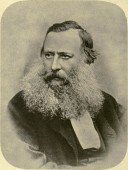
– Order: Psittaciformes
– Family: Psittaculidae
– Genus: Psittacula
– Scientific name: Psittacula calthrapae
– Citation: (Blyth, 1849)
– Protonimo: Palaeornis Calthrapae
Layard's Parakeet Images:
Videos "Layard's Parakeet"
Layard's Parakeet (Psittacula calthrapae)
Sources:
– Avibase
– Parrots of the World – Forshaw Joseph M
– Parrots A Guide to the Parrots of the World – Tony Juniper & Mike Parr
– Birdlife
– Photos:
(1) – Layard’s Parakeet eating fruit in Sri Lanka. Its beak is not fully black, so it is probably a sub-adult female By Hafiz Issadeen (originally posted to Flickr as Layard’s Parakeet) [CC BY 2.0], via Wikimedia Commons
(2) – [BirdPhotoIndia] Layard’s parakeet, Sri Lanka – Indian Birds Photography
(3) – Photo by Steve G near Sinharaja, Sri Lanka, July 28, 2009 – Bird Forum
(4) – An adult of Layard’s Parakeet – World-Birds
(5) – Layard’s Parakeet Psittacula calthropae – Starron Bird and Wildlife
(6) – John Gerrard Keulemans [Public domain], via Wikimedia Commons
– Sounds: David Farrow (Xeno-canto)
